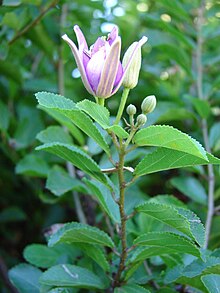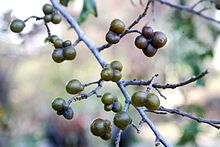Lavender star flower
| Lavender star flower | ||||||||||||
|---|---|---|---|---|---|---|---|---|---|---|---|---|

Lavender star flower |
||||||||||||
| Systematics | ||||||||||||
|
||||||||||||
| Scientific name | ||||||||||||
| Grewia occidentalis | ||||||||||||
| L. |
The Lavender Star Flower ( Grewia occidentalis ), also cross berry called, is a species of plant from the large genus grewia ( Grewia ) adapted to family of the Malvaceae part (Malvaceae). It is widespread in southern Africa .
description
Appearance and leaf
The lavender star blossom grows as a deciduous shrub or small tree and reaches a maximum height of 3 meters. It usually grows upright on its own, rarely climbing. The very thin branches have bare bark .
The alternate, arranged generally in the horizontal, facing the light position on the branches leaves are divided into petiole and leaf blade. The bald petiole is up to 1.3 cm long. The simple, glossy dark green leaf blade is 2 to 7.5 cm long and 1.5 to 4 cm wide, lanceolate, rhombic-lanceolate or obovate-lanceolate with an almost wedge-shaped, rounded or slightly heart-shaped blade base and one pointed or rounded top. On the leaf blade, three distinct leaf veins run from its base. The leaf margin is crenate or toothed. The upper and lower side of the leaf is hairy or glabrous or slightly downy. The early sloping side leaves are hairy with a length of up to 4 mm ruler and fluffy.
Inflorescence and flower
The flowering period in South Africa extends from October to January. One to three up to 12 mm long stalked flowers are in small inflorescences that arise opposite the leaves at the top of the branches. The relatively thin inflorescence stem is glabrous and about 15 mm long.
The radially symmetrical , star-shaped flower has a diameter of 1.5 to 3 cm. The downy hairy, greenish outside and purple or pink inside sepals are linear-oblong with a length of up to 18 mm. The ten mostly purple, pink or mauve colored, rarely white, yellowish center possessing petals are elongated-lanceolate with a length of up to 14 mm and about 1 mm long nailed with nectar glands. The androgynophore is glabrous to a height of about 1 cm and the top 3 mm are intensely hairy. The four-lobed, upper ovary is densely hairy. The up to 10 mm long, bald stylus ends in a scar with wide scar flaps.
fruit
The shiny, bare stone fruit has a diameter of 2 to 5 cm and is clearly four-lobed, lobed (which is also expressed in the common English trivial names "Cross-berry" or "Four-corner" in South Africa ). The somewhat fleshy fruits change their color during the ripening period (January to May) from reddish brown to light purple and remain on the bush for a long time.
Distribution and ecology
The natural distribution area of Grewia occidentalis is in southern Africa : it extends in South Africa from the western Cape region via Botswana and Namibia to Zimbabwe and Mozambique .
Their habitat ranges from the arid areas of the Karoo and coastal dune vegetation to evergreen mountain forests. In the highveld it often grows in groups of bushes in rocky locations, often in the shade of taller trees.
The leaves are eaten by cattle, goats and wildlife (such as rhinoceros , giraffes , nyalas and ducks ). The caterpillars of the butterfly species Eagris nottoana and Netrobalane canopus also feed on their leaves.
Ripe fruits are food for various species of birds such as mouse birds or bulbuls as well as various mammals. Studies have shown that passage of seeds through the intestines of baboons or other monkey species increases their germination rate, as it neutralizes chemical germination inhibitors.
Systematics
The first publication of Grewia occidentalis was carried out by 1753 Carl Linnaeus in Species Plantarum , 2, S. 964. The epithet occidentalis means west. Synonyms for Grewia occidentalis L. are: Grewia chirindae Bak. f. , Grewia microphylla Weim.
The genus Grewia today belongs to the subfamily Grewioideae and was formerly part of the linden family (Tiliaceae), which is now also a subfamily of the mallow family (Malvaceae).
use
The wood was used to make bows and spear shafts.
The fruits are used raw, but especially in areas where they are high in sugar, dried (or later boiled in milk) for later consumption. Sometimes beer is also made from them.
In folk medicine , the lavender star flower is of great importance. Bark soaked in hot water is used to treat wounds. Powdered bark is said to be used for washing hair to prevent it from turning gray. In addition, plant parts were used to treat impotence or infertility . Root extracts should make childbirth easier.
Grewia occidentalis is a decorative ornamental plant that can withstand light frosts and drought.
Individual evidence
- ^ Grewia occidentalis in the Germplasm Resources Information Network (GRIN), USDA , ARS , National Genetic Resources Program. National Germplasm Resources Laboratory, Beltsville, Maryland.
- ↑ First publication scanned at biodiversitylibrary.org .
Web links
- Grewia occidentalis at Useful Tropical Plants.
- Sharon Turner, Walter Sisulu: Datasheet at Plantz Africa - SANBI.
- H. Wild: Tiliaceae. In: Flora Zambesiaca. Volume 2, 1963: Grewia occidentalis - online at KEWScience (section description and systematics).
- Detailed pictures at Malvaceae Info.
- Grewia occidentalis . In: S. Dressler, M. Schmidt, G. Zizka (Eds.): African plants - A Photo Guide. Senckenberg, Frankfurt / Main 2014.

